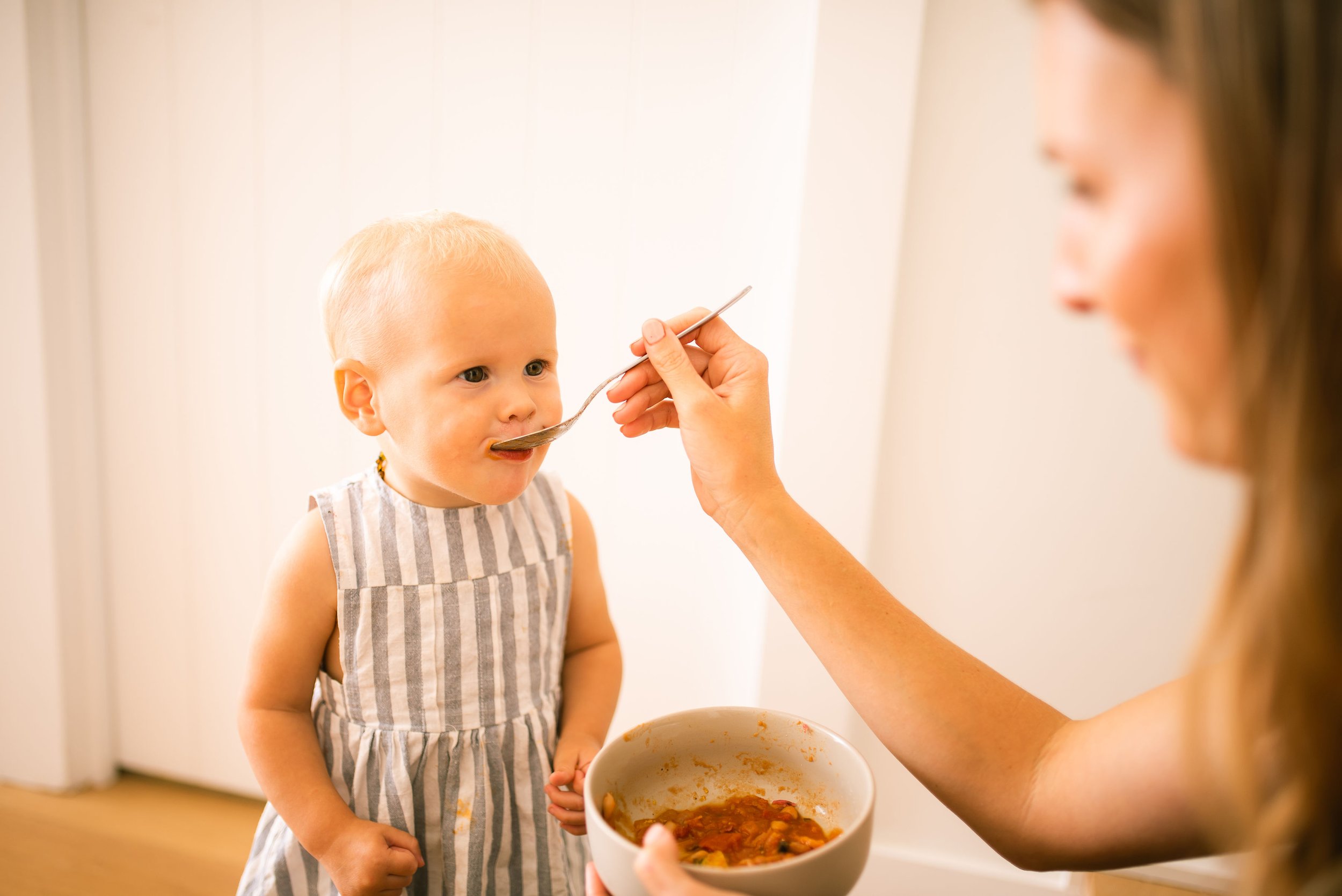There are a lot of terms out there: picky eating, fussy eating, selective eating, problem feeding—if you’re a toddler parent, you’ve likely encountered them, and probably a few of the challenges that come with them! From the moment our little ones arrive, it feels like everything revolves around food. When it’s going smoothly, it’s great. But when it’s not? Well, it can leave parents questioning everything—wondering if it’s just a phase they’ll outgrow or if it’s time to bring in a professional.
Dr. Kay A. Toomey, a paediatric psychologist, offers helpful definitions and frameworks to help parents differentiate between picky eaters and problem feeders.
First things first: What exactly is picky eating?
According to Kay A. Toomey, a picky eater:
- Eats a limited variety of foods, but usually more than 30 different ones
- Chooses at least one food from most food groups
- Has a different food preference than other family members
- Might struggle to get all the nutrition they need
- Is more likely to show negative emotions during mealtimes than other kids
- Could eat differently in various settings (like daycare or a friend’s house)
- Has very specific preferences for how food is prepared and served (Toomey, 2021).
These challenges can last for anywhere between a few weeks and up to two years.
Did you know? Research shows that between 25% and 33% of children under 10 experience feeding or growth difficulties. It’s a common phase many parents face, especially when their once adventurous eaters suddenly become picky in toddlerhood. Factors like growing autonomy (hello, “I can do it myself!” phase), slowing growth, and more sensitive sensory systems can all contribute. Not to mention, toddlers’ protective instincts kick into gear, and they become extra cautious with new foods. New research also suggests that about 50% of fussy eating behaviour can be attributed to genetic factors (Nas et al., 2024).
So… is this just a phase?
Turns out, about 1/3 to 1/2 of picky eaters will grow out of it in 2-3 years—no therapy needed. But for 3-10% of kids, picky eating could evolve into a more persistent feeding or growth challenge. That’s when we start talking about “problem feeders.”
What is a problem feeder?
Dr. Toomey draws a line between picky eaters and problem feeders, and the difference is important. Problem feeders are kids who face ongoing, significant challenges with feeding and growth.
A problem feeder:
- Eats a very limited range of foods (usually less than 20)
- Refuses entire food groups or textures
- Almost always eats different meals than the rest of the family
- Needs to eat separately from the family at mealtime
- May have meltdowns when faced with new foods
- Likely struggles with growth or nutrition (Toomey, 2021)
Many children who are considered problem feeders could be dealing with something called a Paediatric Feeding Disorder (PFD). PFD is defined as impaired oral intake that is not age appropriate, lasting at least 2 weeks and associated with medical, nutritional, feeding skill, and/or psychosocial dysfunction (Goday, 2019). An assessment by a feeding therapist is needed to identify a PFD. Timely and multidisciplinary intervention is key for these children. One conservative study recently found that in the United States 1 in 37 children under the age of 5 are affected by a Paediatric Feeding Disorder (Kovacic, 2020).
So, what’s the next step?
If you’re wondering whether your child falls under the “problem feeder” category, it’s important to start with a thorough assessment. Chat with your GP or paediatrician, or book a consult with a speech pathologist, occupational therapist, or a dietitian who specialises in paediatric feeding (we have one of those in our online clinic!).
If your child is simply a picky eater, there are plenty of ways you can support them at home. Below, we’ve summarised some of our favourite strategies to make mealtimes less stressful—and maybe even a little fun!
Picky Eating Tips for Parents
While we often think of picky eating as a “phase,” the way we handle it can determine how long it sticks around. Here’s how to support your little one:
- Ditch the “lick your plate clean” philosophy: Research consistently shows that forcing a child to eat a food or finish a meal can lead to increased anxiety around food and can override internal hunger and fullness cues.
- Family mealtimes matter: Eating together fosters connection and encourages children to try a variety of foods. Research indicates that children who eat with their families are more likely to consume a wider range of fruits and vegetables throughout childhood and into adolescence (Larson et al., 2013).
- Offer variety, even for exposure: Introduce a wide range of foods from the start of your child’s solids journey and continue this throughout toddlerhood and childhood. Make meals sensory-rich and visually appealing. Research shows it can take 8-15 exposures to a food before your child is ready to try it (Carruth et al., 2004).
- Know your role: Stick to the division of responsibility (Satter, 2000). This approach nurtures intuitive eaters and fosters healthy relationships with food. As caregivers, our role is to decide when and where meals take place and what food is served. It’s up to our children to determine whether and how much they eat. Serving food in a buffet or platter style can facilitate this, allowing them to listen to their bodies.
- Keep pressure low: Create a relaxed atmosphere at mealtimes. Avoid using rewards, bribes, or negative pressure. Praise for “good eating” can create anxiety; instead, focus on enjoying the meal together.
- Embrace the mess: Don’t stress about spills or mess during meals. Allowing your child to explore food can enhance their comfort and curiosity.
- Routine is key: Aim for 2-3 hours between meals and snacks to help build awareness of hunger and fullness cues. Consistency helps children understand mealtime expectations and ensures that snacks don’t sabotage meals.
- “Safe” or preferred foods: At each meal or snack, include at least one food your child enjoys and will eat at least 90% of the time, alongside other foods. This ensures they feel safe and calm at mealtimes and have something to fill their tummies.
- Don’t become a short-order cook: Avoid the trap of making “backup” or alternative meals. If you’ve prepared a meal that includes at least one highly preferred food and considered sensory needs and taste preferences, there’s no need for backup meals. If your child refuses food, acknowledge their feelings but maintain boundaries. Encourage open communication about what could make the meal more appealing, such as adding a sauce, cutting food into smaller pieces, or removing something from the plate.
And if you’re looking for more strategies (and some delicious, nutritionist-approved recipes), check out our book, Toddler to Table, packed with tips and family-friendly meals!
References:
Carruth, B.R., Ziegler, P.J., Gordon, A. and Barr, S.I. (2004). Prevalence of picky eaters among infants and toddlers and their caregivers’ decisions about offering a new food. Journal of the American Dietetic Association, [online] 104, pp.57–64. doi:https://doi.org/10.1016/j.jada.2003.10.024.
Goday PS, Huh SY, Silverman A, et al. paediatric Feeding Disorder: Consensus Definition and Conceptual Framework. J Pediatr Gastroenterol Nutr. 2019;68(1):124- 129. doi:10.1097/MPG.0000000000002188.
Kovacic K, Rein, ScM LE, Bhagavatula P, Kommareddy S, Szabo A, Goday PS, paediatric Feeding Disorder: A Nationwide Prevalence Study, The Journal of paediatrics (2020), doi: https://doi.org/10.1016/j.jpeds.2020.07.047.
Larson, N., MacLehose, R., Fulkerson, J. A., & Berge, J. M. (2013). Family meals during adolescence are associated with higher diet quality and healthful meal patterns during young adulthood. Journal of the American Dietetic Association, 113(12), 1601-1607. doi: 10.1016/j.jand.2013.07.032
Nas, Z., Herle, M., Kininmonth, A. R., Smith, A. D., Bryant-Waugh, R., Fildes, A., & Llewellyn, C. H. (2024). Nature and nurture in fussy eating from toddlerhood to early adolescence: Findings from the Gemini twin cohort. Journal of Child Psychology and Psychiatry, 65(3), 340–350. https://doi.org/10.1111/jcpp.14053
Satter, E. (2000). Child of Mine: Feeding with Love and Good Sense. Bull Publishing Company.
Toomey, K.A., and associates, 2021. Picky Eaters vs paediatric Feeding Disorder (PFD) vs Avoidant Restrictive Food Intake Disorder (AFRID): Differential Diagnosis Decision Tree




+ show comments
- Hide Comments
add a comment